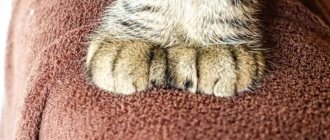It has many names: sandy, dune, Arabian, desert, and in all cases we are talking about one species of cat - the dune cat, discovered for the first time in 1858 in Northern Sahara, during a French expedition led by Captain Jean-Auguste Margueritte ).
The first description of the animal was given by researcher, French army captain and naturalist Victor Loche, who named the species Felis margarita in honor of the leader.
In 1926, researcher Sergei Ognev described the Turkestan subspecies of the sand cat; in total there are 5 subspecies, differing in color:
- Felis margarita margarita, distribution area - Sahara,
- Felis margarita meinertzhageni – Algerian Sahara,
- Felis margarita harrisoni - on the Arabian Peninsula,
- Felis margarita scheffeli – Pakistan,
- Felis margarita thinobia – Iran, Turkmenistan, Kazakhstan.
What does a sand cat look like?
The length of the body of a dune cat together with the tail does not exceed 90 cm, height - up to 30 cm. The weight of an adult male is no more than 3.5 kg. A distinctive feature of this wild cat is its wide, long ears and flattened head with whiskers. The eyes are yellow or green with slit-like pupils.
The fur on the body of a desert cat is thick and silky, which protects the animal from temperature changes in deserts. The short paws are covered with tough fur, which allows the cat to move freely on the hot sand. The tail and back of the predator are colored with gray-brown stripes, while the color of the fur varies from light red and beige to gray.
Did you know? The fur of the sand cat is not used in any way in industry, so the species is not hunted by humans.
Character of a wild beast
Dune cats are nocturnal animals; only the subspecies from Pakistan can be active at dusk. When hunting, the animal can cover distances of up to 10 km. During the daytime, these cats sleep in the burrows of other animals, for example, foxes, porcupines, corsacs, and ground squirrels, and also dig out burrows of small rodents for overnight stays.
Important! This species hides all signs of its vital activity. The fur on the feet helps the animal not leave marks. In addition, the cat buries all food waste and never returns to the prey.
The sand cat is hunted by larger predators. These can be jackals, snakes, monitor lizards, as well as birds of prey.
Hunting
Not everyone can survive in the harsh desert conditions. But the sand cat will not disappear - it is a born hunter who easily copes with the task of finding prey. A cat usually attacks from an ambush - it jumps out of cover, grabs the victim by the neck and shakes it thoroughly. Then teeth and claws are used to slowly feast on the prey, piece by piece.
This is interesting! Before leaving the shelter, the cat freezes and listens to its surroundings in order to avoid danger, and after the hunt the animal listens, trying to find out whether the home was occupied during its absence.
A meal of eating large prey can last for several days. All this time, the dune cat will remain in the shelter and will come out only when there is nothing else to eat.
Features of life in the wild
Males and females of this species live separately, but their home territories overlap.
Where does he live?
The sand cat, as the name suggests, lives in deserts or places with arid and hot climates. The cat's habitat includes the territory of the Sahara, Central Asian countries such as Turkmenistan, Uzbekistan, Kazakhstan, and Pakistan.
Did you know? In Kazakhstan, this species of the cat family is listed in the Red Book.
Depending on their habitat, there are several subspecies of cats that differ from each other in coat color:
- Felis margarita margarita. Lives in Sahara. It differs from other species in its smallest size and brightest color. May have from 2 to 6 rings on the tail;
- Felis margarita harrison. Inhabits the Arabian Peninsula. Distinctive features are spots on the outside of the ear and a tail with 5–7 rings;
- Felis margarita thinobia. It lives in Iran and Turkmenistan, which is why it is also called the Caspian cat. Individuals of this subspecies are the largest and have the least prominent color;
- Felis margarita scheffeli. The subspecies resides in Pakistan. The color of the coat is muted, but the cat’s back is decorated with dark stripes, and the tail is usually marked with several rings.
What does it eat?
The sand cat feeds on small game, which it hunts at night, which calls into question the possibility of keeping it at home. Its diet includes snakes, including horned vipers, sand mice, jerboas and other rodents, hares, birds, and insects. During the hunt, the predator first stuns the victim with a blow to the head, and then strikes with a bite to the neck.
In winter, cats live closer to human settlements, but do not hunt poultry. The predator lives far from bodies of water, so the bulk of the liquid enters its body through the food it eats. An animal can live without water for quite a long period of time.
How does it reproduce
The mating season of these mammals occurs individually, depending on the climate and the characteristics of the subspecies itself. The Central Asian subspecies mates in spring or early summer, and the inhabitants of the Sahara - in winter or early spring. The beginning of the mating season in males is accompanied by sounds reminiscent of a dog barking, which should notify and attract the female.
Familiarize yourself with the features of caring for the jungle cat, Serengeti, caracal, manul and oncilla.
There are usually about 3-4 kittens in the litter, which she gives birth to in a spacious burrow. The female lives with her offspring for up to 6–8 months, teaching them to hunt. Then, at the age of 9 months, young cats become sexually mature and begin an independent life. The lifespan of this species is up to 14 years.
Lifestyle of a sand cat
The sand cat prefers to live in deserts, and even drought is not able to scare it. Occasionally, the predator climbs onto rocks or clay deserts. They survive in such wild conditions only thanks to hunting. Families of desert cats inhabit burrows. Sometimes the hole of another animal (for example, a fox) is brazenly used for this, but the Arabian cat can dig its own. Animals spend time in shelters waiting for the night. In the shade, the cat’s body practically does not lose fluid, due to this the animal can do without water. When night falls, the predator goes out hunting, moving along the sand almost crawling. However, the “plastic” manner of movement does not prevent the cat from walking 10 kilometers in one outing. This animal sleeps during the day.
sand cat - nocturnal predator
Arabian cat nutrition
These predators easily get food directly from the sand (lizards, porcupines, etc.). Thanks to excellent hearing and the special structure of its ears, the sand cat can detect a barely audible rustling underground. This is how they catch various rodents. The whiskers help the wild animal detect the slightest vibrations in the air (this predator loves to destroy bird nests). In general, the desert cat eats any living creature that it manages to catch:
- jerboas;
- gerbils and ground squirrels;
- small birds and their chicks;
- monitor lizards and geckos;
- small hares;
- insects, etc.
It is also interesting how a desert cat kills a captured animal. If, for example, a hare or gopher becomes prey, the predator sinks its teeth into the victim’s neck and shakes it violently. When the poor guy's spine breaks, the cat tears his body into several pieces.
Reproduction
At six months, sand cats begin to live an independent life, but become sexually mature somewhat later (9–14 months). Adult females give birth only once a year. Moreover, pregnancy occurs in the middle of winter, and childbirth occurs in early spring. Weather conditions are important - the nature of these cats is designed in such a way that kittens should be born closer to the onset of warm weather. For example, Arabian cats living in Africa give birth between January and April. Pakistani populations “walk” in September-October. Individuals living in zoos and nurseries can give birth more often, since it is easier to survive in artificial conditions, and therefore vital energy can be directed to procreation.
Dune cats give birth only once a year
With the beginning of the mating season, the choice of a partner begins. Both males and females can initiate contact. At this time, animals make sounds reminiscent of barking. That's why desert cats are called the only cats that bark. These sounds resemble the barking of a small dog.
The pregnancy of a sand cat lasts approximately 2 months. At this time, the pregnant cat is looking for a free and comfortable hole. And in cases where the home was never found, the expectant mother digs it out herself. One litter can have from 4 to 8 kittens. Dune cat babies are much smaller than domestic animal kittens. The weight of one sand kitten can only reach 30–31 g. After about 2 weeks, the kitten opens its eyes, and after a month it is already trying to participate in the hunt with its mother. This is how a cat teaches its cubs to survive.
We recommend reading: French food “Flatazor” for cats: what to choose
The average life expectancy of sand cats is shortened by early mortality of kittens
Due to early training in hunting, many dune kittens die in the first months of their lives (kitten mortality rate is 40–42%). The average lifespan of an adult sand cat living in the wild is 10–11 years.
Many zoologists believe that representatives of this species live less than domestic cats. But I heard that desert cats sometimes live 20 years. This may be due to the fact that predators hide, and hunting becomes more difficult with age. In addition, an old and low-energy body needs less food, which means the number of outings decreases. Therefore, there is a possibility that older dune cats are simply difficult to find. I was told that poachers often find small sand kittens (due to their inexperience) and older individuals hiding in holes (because they do not have time to escape).
Can I keep it at home?
Keeping wild cats at home can harm not only the owners, but also the animal itself. In addition, the Arabian sand cat is an animal whose population is under threat, and therefore its price starts from 6 thousand dollars and above. This rather rare representative of the cat family will not only cost you a tidy sum, but will also cause a lot of inconvenience.
Important! For the sand cat, it is important to create climatic conditions in which the air humidity is very low. In captivity, cats are also susceptible to viral diseases.
Firstly, such a cat cannot be found in a simple nursery, and secondly, it is not known what vaccinations can and should be given to the animal. Of course, a wild animal such as the sand cat rarely breeds in captivity, so its price will only increase and its population decrease.
The sand cat is a unique species of mammal that is not recommended to be kept indoors. The animal leads a rather secretive lifestyle and its domestication is unlikely to give owners the joy of such a pet, because in captivity such cats often get sick.
Lifespan
The lifespan of sand cats in captivity reaches 13 years. However, it is impossible to determine how many years a cat lives in the wild. The reason for this is the hidden lifestyle that animals adhere to.
Enemies in nature
The enemies of velvet cats in nature include jackals, wolves and large birds of prey. Humans can also be considered the enemy of wild cats, since people often hunt them for sale, however, in captivity, velvet cats are less than 10 years old and reproduce no more than 2 times a year.











